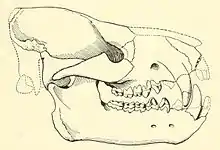Helohyidae
Helohyidae were a group of artiodactyl mammals.[1] [2] They were most prominent in the mid-to-upper Eocene (~50 to 39 million years ago), although some fossils were found on land in the upper Oligocene (~28 million years ago).[3]
| Helohyidae | |
|---|---|
 | |
| Reconstruction of the skull of Achaenodon | |
| Scientific classification | |
| Kingdom: | Animalia |
| Phylum: | Chordata |
| Class: | Mammalia |
| Order: | Artiodactyla |
| Family: | †Helohyidae |
Description
Helohyidae share vague similarities to present-day pigs, though were slimmer in build. They possessed prominent canines and molars with bunodont cusps, bulging dental wreaths, and wrinkled enamel. Their upper molars were usually squared, due to the enlargement and displacement of the metaconule, but there was also a small hypocone and hypoconule. The paraconule was reduced and there was no mesostyle. Their lower molars increased in size as they proceeded to the bottom of the jaw, and the paraconid was small or absent. Some forms (e.g. Gobiohyus) possessed small diastemas that separated the premolars from each other. The snout was usually elongated (e.g. in Helohyus), but in some forms ascribed to this family (Achaenodon), it was very short. Compared to other primitive artiodactyls such as dichobunids, they possessed higher sagittal ridges; the genus Achaenodon, in particular, possessed a large sagittal crest and its size was much larger than those of other helohyids.
Classification
The family Helohyidae was established by Marshall in 1877 to accommodate some forms of early artiodactyl mammals of the American Eocene. In addition to the genus Helohyus, the North Americans Dyscritochoerus, Parahyus and Achaenodon were later ascribed to this family. Other forms come from the Upper-Middle-East Eocene of Asia (Gobiohyus[4] of Inner Mongolia, Pakkokuhyus of Burma and Progenitohyus[5] of Thailand. The latter form may be close to the origin of the family of hippo-like anthracotheres. The last known helohyid is Simojovelhyus of The Upper Oligocene of Mexico: the discovery of this form implies the existence of a ghost lineage of helohyids of about 10 million years.[6]
Helohyids have been variously classified as relatives of archaic dichobunids or as close to the origin of anthracotheres. The current opinion is to classify them as relatives of the dichobunids.[7]
References
- Ducrocq, Stéphane; Chaimanee, Yaowalak; Suteethorn, Varavudh; Jaeger, Jean-Jacques (September 1, 1997). "First discovery of Helohyidae (Artiodactyla, Mammalia) in the Late Eocene of Thailand: a possible transitional form for Anthracotheriidae". Comptes Rendus de l'Académie des Sciences - Series IIA - Earth and Planetary Science. 325 (5): 367–372. doi:10.1016/S1251-8050(97)81385-7 – via ScienceDirect.
- "Fossilworks: Helohyidae". fossilworks.org.
- "Helohyidae". www.gbif.org.
- Coombs, Margery C.; Coombs, Walter P. (20 August 1977). "Dentition of Gobiohyus and a Reevaluation of the Helohyidae (Artiodactyla)". Journal of Mammalogy. 58 (3): 291–308. doi:10.2307/1379328. ISSN 0022-2372. JSTOR 1379328.
- Ducrocq, Stéphane; Chaimanee, Yaowalak; Suteethorn, Varavudh; Jaeger, Jean-Jacques (September 13, 1997). "First discovery of Helohyidae (Artiodactyla, Mammalia) in the Late Eocene of Thailand: a possible transitional form for Anthracotheriidae". CRASE. 325 (5): 367–372. Bibcode:1997CRASE.325..367D. doi:10.1016/S1251-8050(97)81385-7.
- Ferrusquea-Villafranca, 2006
- McKenna and Bell, 1997; Stucky, 1998; Rose, 2006